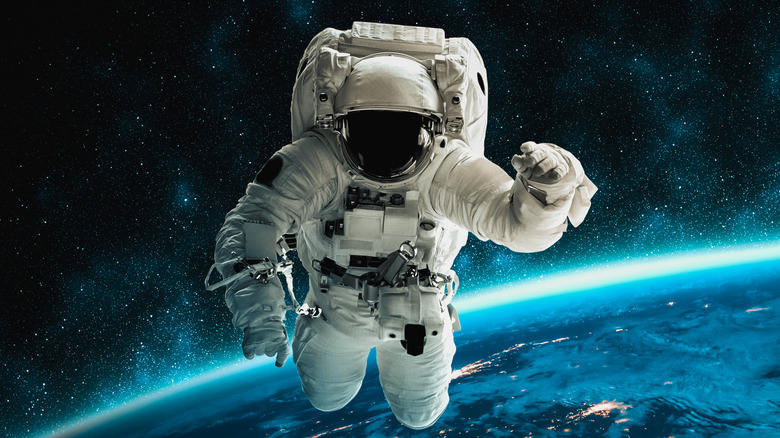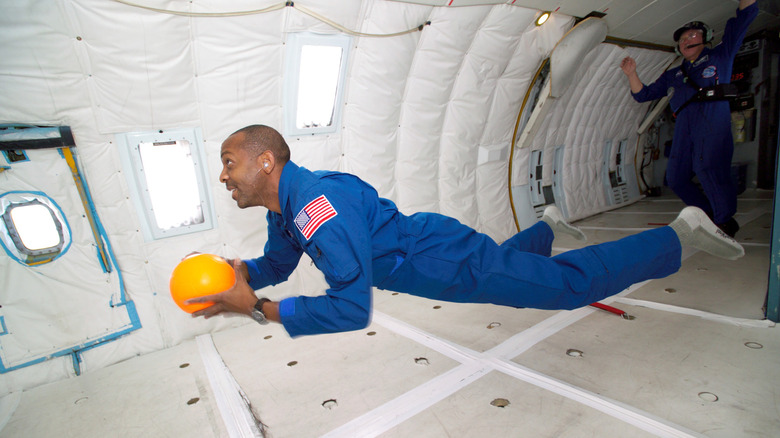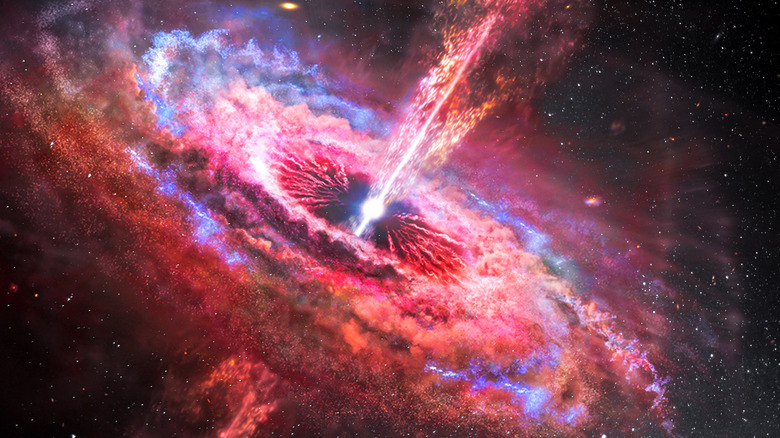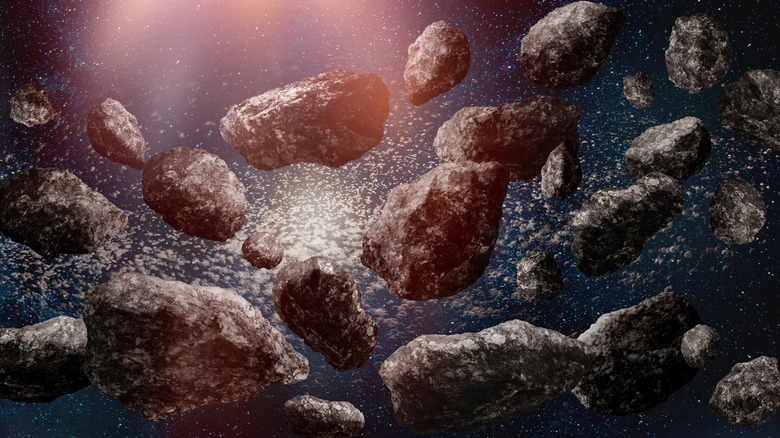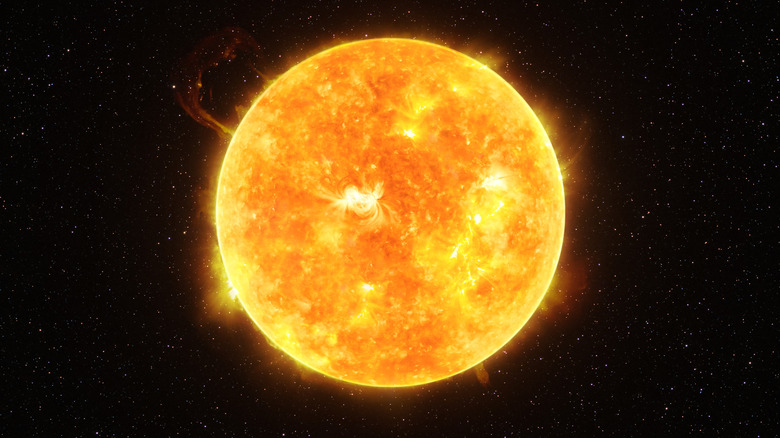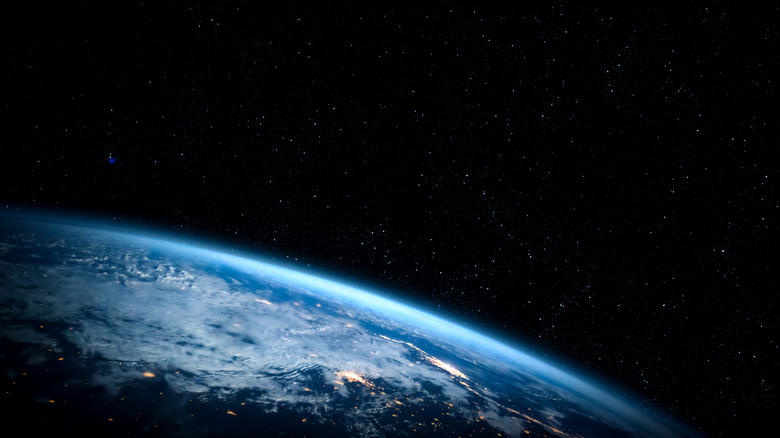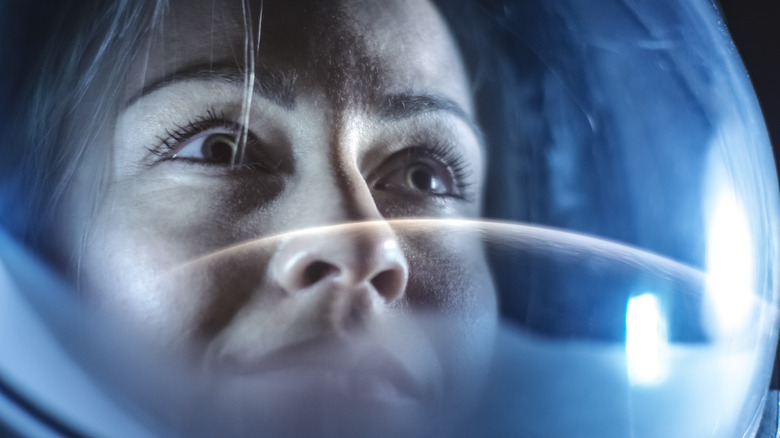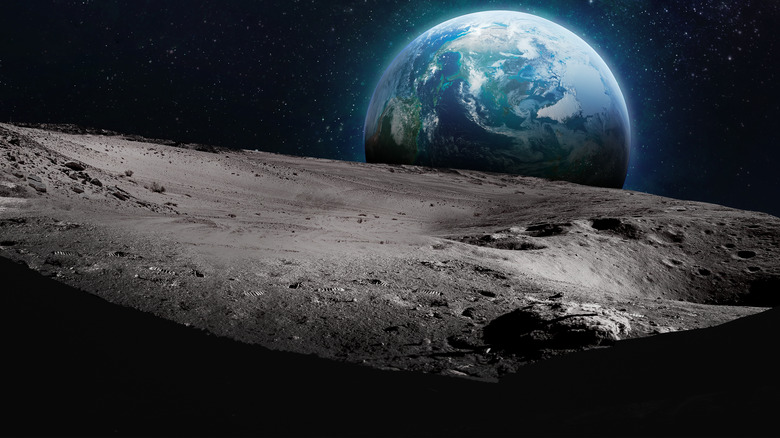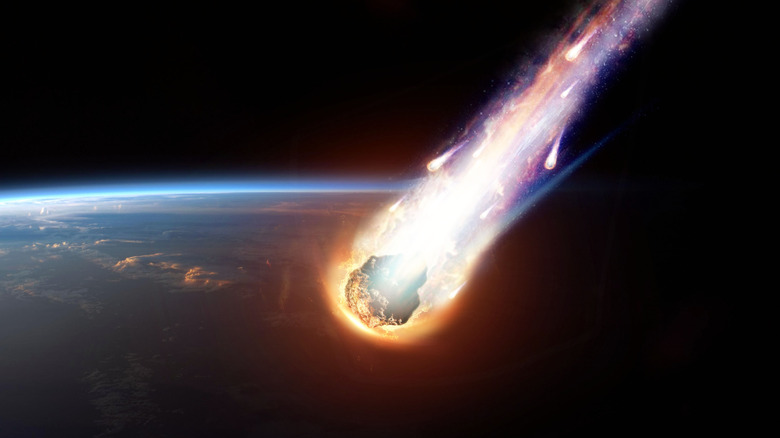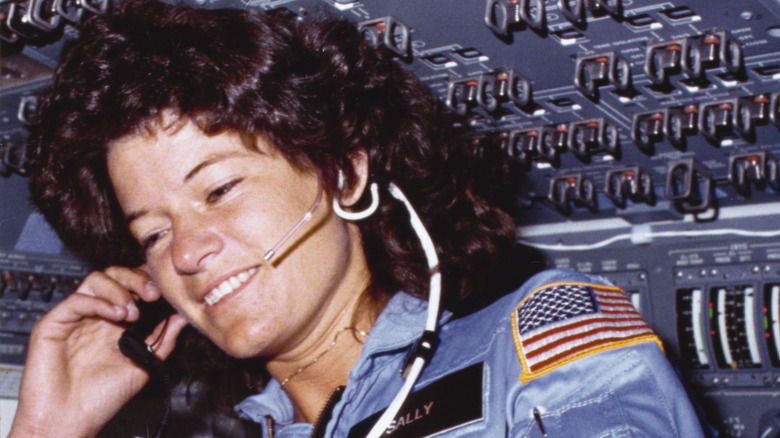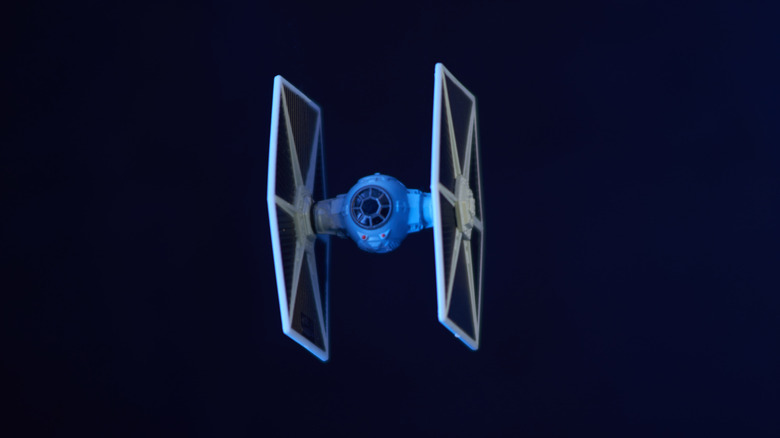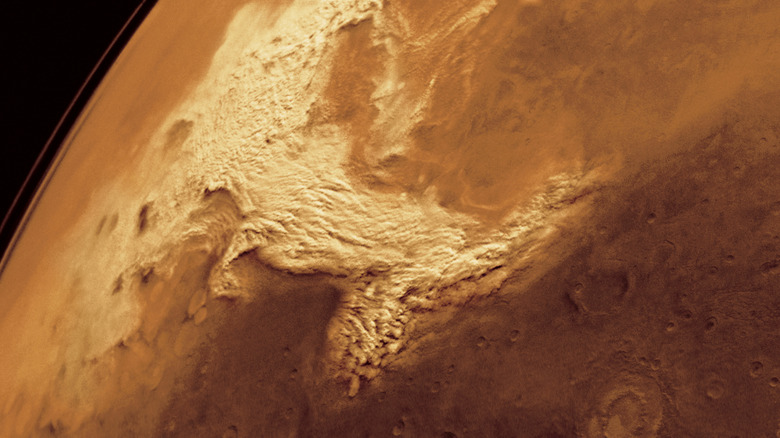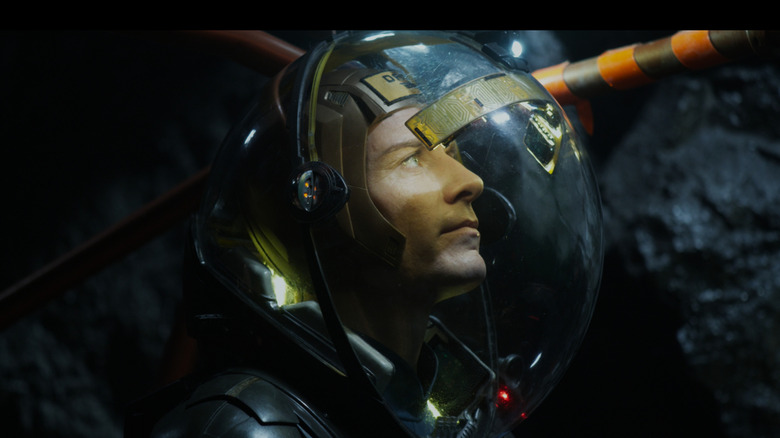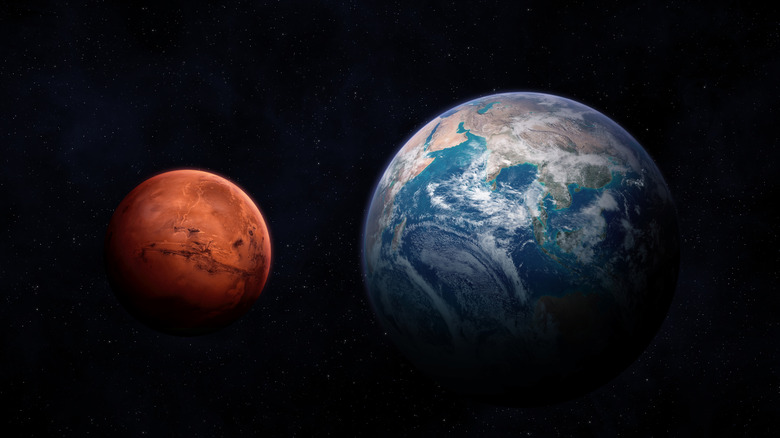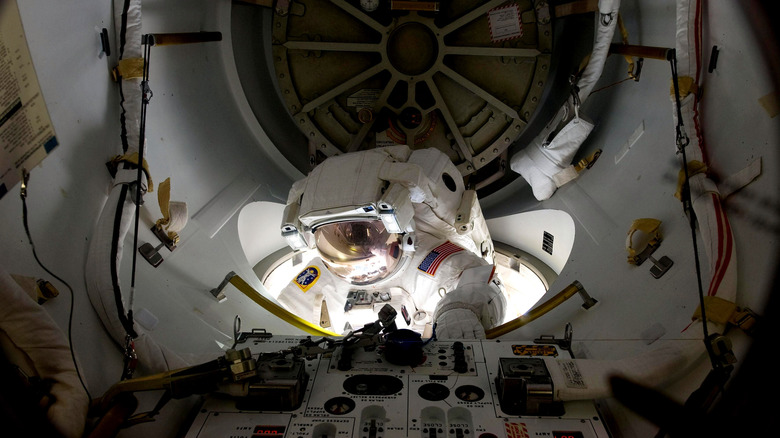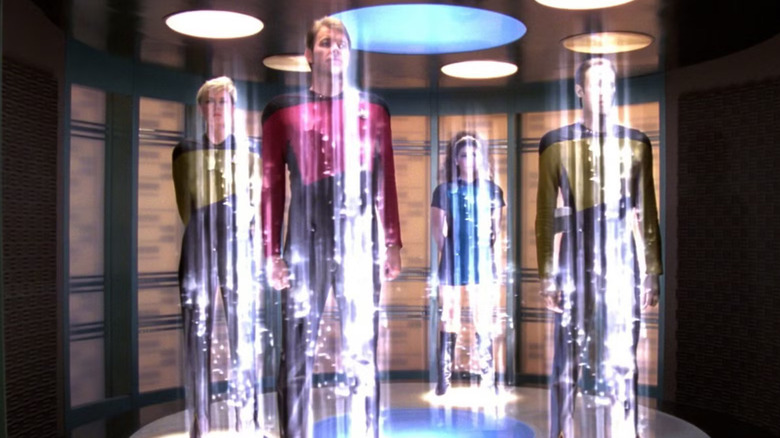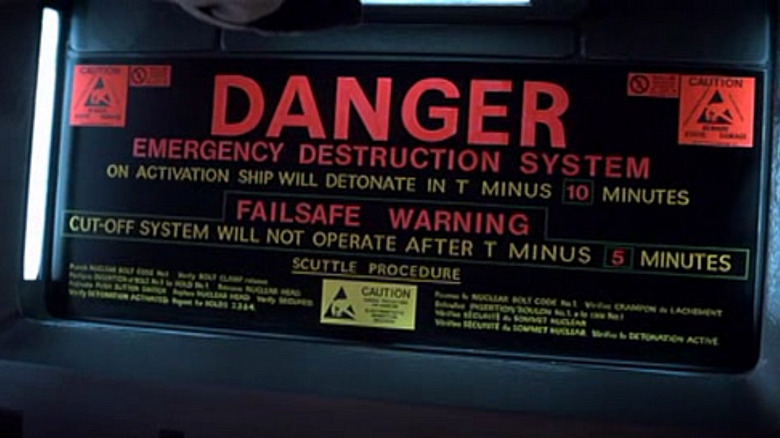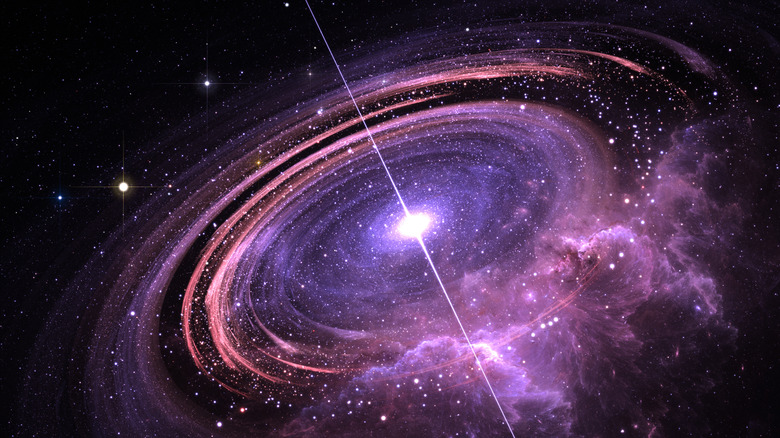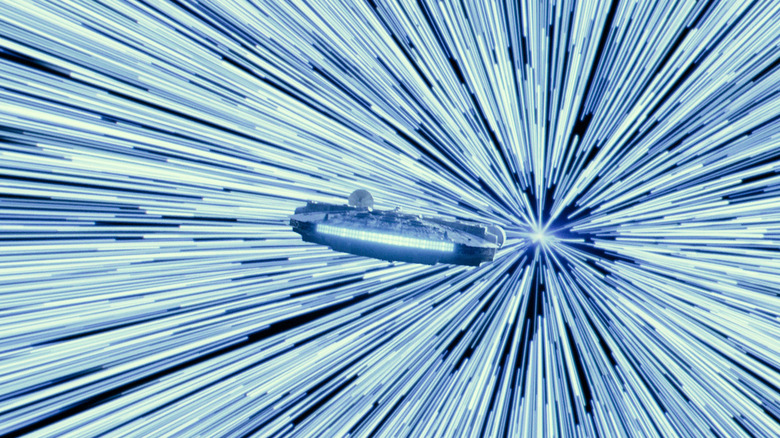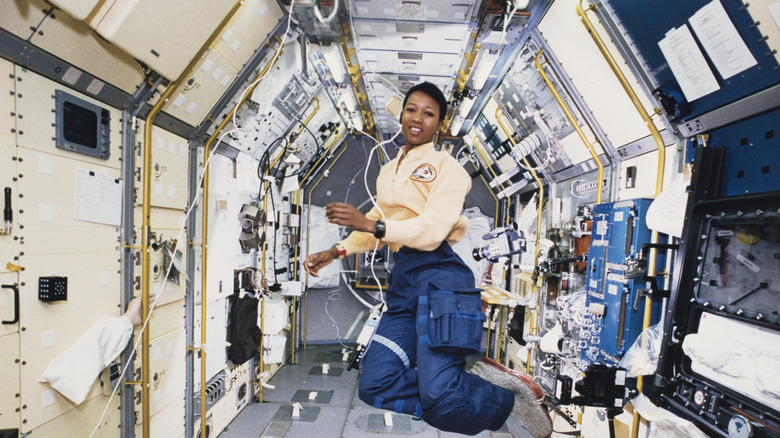Things About Space That Movies Get Wrong
Space has long enthralled and fascinated humanity, quite likely ever since the first human looked up at the night sky and saw bright dots in a vast ocean of darkness. Within the last century, humanity's knowledge and awareness about what lies beyond Earth has greatly increased. Humanity has managed to travel outside the planet's boundaries and even reach the Moon.
That said, there's still a lot about space that needs to be discovered and understood. In works of fiction and popular culture — especially in movies — the gaps in our knowledge of space have been filled by creativity and speculation. This has led the general public to assume that the way things play out in outer space on the silver screen accurately reflects how they would turn out in real life.
Of course, no one really goes to the movies to learn about astrophysics or find out if there really is no gravity in space. Still, identifying the things about space that movies get wrong is a fun exercise — one that doesn't necessarily denigrate the films that are guilty of certain interstellar myths and half-truths, but instead paves the way for correcting misconceptions about the cosmos.
Explosions in space are like explosions on Earth
In films like "Star Wars" and "Star Trek," it's not uncommon to see spaceships blowing up space debris or even other spacecraft. These sequences typically end in bright, fiery spectacles, which really helps sell the idea to audiences that something just exploded. There's just one small problem: Objects that get blown up in space wouldn't really look or sound like Earth-bound explosions.
As Science Focus explains, when stars, planets, and other celestial bodies "explode," the process involves a powerful release of energy and matter. This can happen either from within them or due to external forces. Either way, they undergo fundamental changes. What they don't do, though, is turn into gigantic fireballs like, say, an exploding car would. In the vacuum of space, such a flaming spectacle — which requires either oxygen or an additional oxidizing substance — wouldn't happen.
Additionally, whatever explosion comes out of this situation wouldn't be as loud as the space explosions we see in many science fiction movies. Due to space being a vacuum, the released gases would rapidly expand as the density decreases. In other words, any sounds that accompany the gas would become less audible over longer distances, and this would all happen very fast. Cornell Astronomy presents an interesting scenario that illustrates this: Even if you were aboard a spacecraft and an adjacent ship exploded, you'd be more likely to hear the pieces of the ship hitting your craft than any sounds from the actual explosion.
There is no gravity in space
One of the most common misconceptions about space is that it has no gravity. Countless films show characters floating around (either in the vastness of space or within their own spaceships), which serves to reinforce this belief. It also doesn't help that when talking about space-related topics, the term "zero gravity" tends to be taken literally. The truth, however, is that there is gravity in space — just a lot, lot less than the gravity here on Earth.
As NASA explains, an infinitesimal amount of gravity can be found everywhere in space. That's why it's called "microgravity": There's so little of it that when things or people make it to space, they seem to float as if they're lighter than feathers. If one were to remove gravity from space, the results would be catastrophic: For example, without gravity, planets and their moons wouldn't be able to maintain their orbits.
According to Dr. Christopher S. Baird, Assistant Professor of Physics at West Texas A&M University, the microgravity in space causes things to constantly fall towards celestial bodies. He also provides two reasons why things in space seem to be simply floating instead of falling: "First, space is very large and relatively empty by earth standards ... The second reason that gravity is not so obvious in space is because objects tend to orbit planets instead of hitting them. Orbiting just means that an object falls towards a planet due to gravity and continually misses it."
Black holes suck everything in
The idea that black holes suck everything in has become so prevalent in popular culture that people even use it as a metaphor. This has reinforced the notion that black holes are "giant space potholes" that rapidly pull everything in. One of the most recent examples of this was how the Narada got destroyed in the "Star Trek" reboot — audiences witnessed its speedy end in spectacularly destructive fashion. However, such a scenario wouldn't play out like that in real life. In other words, black holes don't exactly work like cosmic vacuum cleaners.
Space.com puts it quite plainly: "Black holes don't suck." They don't have infinite suction power to draw everything within their vicinity into them. Instead, objects that end up very close to black holes fall into them and are unable to escape their gravitational pull. "At a distance, black holes really don't have more gravity than normal objects, so at a distance they really won't suck things in any more than a normal object of the same mass," explained Jerry Fishman, a scientist from NASA's Marshall Space Flight Center, in an edition of the agency's Ask an Expert chat.
That said, this doesn't mean that falling into a black hole won't be an absolutely awful experience. A 2012 study published in Nature theorized that due to quantum effects, you would likely be burnt to a crisp as you pass through the event horizon (the black hole's "point of no return").
It would be hard to fly through the asteroid belt
People who grew up idolizing the likes of Han Solo likely believe that piloting a spacecraft requires unbelievable dexterity and driving skills. And while operating any vehicle does require a decent level of technical expertise, the idea that a space driver would have to pull off a Hail Mary every time they cross a formation like the asteroid belt between Mars' and Jupiter's orbits is a bit misleading.
According to Cornell Astronomy, asteroids and other rock formations in space are spread out widely enough that the possibility of a spacecraft colliding with them is extremely small. For starters, Earth's systems are capable of detecting asteroids that are up to 50 km (about 31 miles) in size. Plus, as far as space missions are concerned, their routes are mapped out years before takeoff, which essentially means that driving a spacecraft is more about following a plan and accounting for minor inconsistencies in the trajectory, and less about driving like a space cowboy. As David Morrison of the NASA Ames Research Center explained to Scientific American: "Collisions are thus extremely rare; an average 1-kilometer asteroid suffers one collision every few billion years, or maybe one or two collisions over the lifetime of the solar system."
That said, space collisions do happen, and can still cause some problems. Per Cornell Astronomy, sand-sized micrometeorites and cosmic radiation often hit spacecraft hulls, which can result in anything from minor damage to technical glitches.
The Sun is yellow (and on fire)
Ask an average person on the street — or perhaps even better, ask the people behind the films "Sunshine" and "Green Lantern" — to draw and color a picture of the Sun. They'd probably ask you for a piece of paper, a pencil, and a yellow crayon, and give you a sketch of a giant yellow fireball minutes later. (Or they'd just walk away from you, because who randomly asks strangers on the street to draw the sun, right?)
In reality, though, the Sun is neither yellow nor on fire, at least not in the traditional sense. According to NASA StarChild, the Sun's impressive cosmic glow is the result of protons smashing into each other within its gaseous body. This process is called nuclear fusion, and when the particles collide, they release energy. Per estimates from Space.com, the sun turns 700,000,000 tons of hydrogen into 695,000,000 tons of helium every second, and the resulting energy released is gamma radiation. Unlike a fire, oxygen doesn't need to be present for this to happen (although high pressure and temperatures are definitely a must).
While the Sun is classified as a yellow dwarf star and certainly does look yellow to human eyes, its true color is actually white (via Science Focus). It only appears to be yellow because when the light reaches Earth's atmosphere, blue light gets scattered — and the remaining wavelengths that reach the planet make the star look yellow.
You can hear sounds in space
When it comes to movies set in outer space, sound tends to be a peculiar aspect. On one hand, anyone who was raised on a diet of "Star Trek" or "Star Wars" likely hears the "Pchew! Pchew!" of lasers fired from spaceships in their heads. On the other hand, there's that ominous-sounding (pun intended) tagline of 1979's "Alien": "In space no one can hear you scream." The reality is a bit less simple than either scenario (but is a lot closer to the latter).
Per Cornell Astronomy, air is absent in the vacuum of space. Which is a problem if you want to hear things, because hearing sound is only possible when there's a proper medium for molecules to vibrate through. That's why light can travel through space with no problem — it doesn't need air — but isn't accompanied by sound. That said, because there are gas clouds in space, sound can travel through them. However, because they're not as dense as the gases in Earth's atmosphere, human ears aren't designed to hear the sounds that travel through them. A powerful microphone designed for such a purpose could possibly pick them up, though.
As for sound traveling unassisted between planets, because there isn't really any matter (solid, liquid, or gas) between, say, Earth and Venus through which sound waves could travel, it just wouldn't work. Long story short, "Alien" got it right — if by "no one," it meant "no human without the proper technology."
Nothing is faster than light
When people hear the words "speed of light," they usually think of it as an impossible-to-surpass speed limit. After all, 670,616,629 mph is certainly nothing to scoff at, right? And while it's true that the laws of physics prevent anything with mass to travel faster than light — meaning you won't be able to physically take a spaceship beyond the limits of the speed of light — to say that nothing can travel faster than light isn't 100% accurate.
As Business Insider explains, a sort of "luminal boom" takes place when electrons travel faster than light in water. The formal term for this is Cherenkov radiation (named after the physicist who first measured it), and it manifests as a blue glow, typically in nuclear reactors. Britannica defines it as "light produced by charged particles when they pass through an optically transparent medium at speeds greater than the speed of light in that medium." So technically, because of the medium in which the particles are traveling, they outpace the light that's also moving through it; however, they're not moving faster than the actual speed of light.
But if that's the case, then how can humanity ever unlock the secret of instant teleportation? Scientists will need to get a bit more creative. Space.com suggests focusing not on the object that will be transported, but on the space around it (e.g. "a spaceship that could fold a space-time bubble around itself").
A person without a spacesuit would instantly explode in space
When "Total Recall" showed audiences the consequences of an astronaut's helmet cracking while on a mission, the results were disturbing, to say the least. However, while an unprotected human would certainly have an unpleasant experience in space, it probably wouldn't unfold that way. For starters, astronauts' suits are designed to hold up against space wear and tear, as NASA astronaut Nicole Stott explained in a video for Wired.
More importantly, a naked human body wouldn't instantly blow up or freeze to death in outer space — but what would happen inside that body would be far more horrific. As Dr. Christopher S. Baird of West Texas A&M University put it: "Even though outer space represents a lack of air pressure, which usually counters the internal pressure in our bodies, our tissue is strong enough to handle the imbalance." It's actually the lack of oxygen that would kill an unprotected person in outer space. That, and sudden decompression, which is one of the worst ways to die for a human being. According to Harvard University, the air in a person's lungs would expand rapidly in the vacuum of space, which could result in lung rupture, ebullism (which could turn one's tissues into vapor), blood vessel blockage, and death. Experiments have revealed that in such a vacuum, a person can survive for about a minute, tops.
The dark side of the moon
The dark side of the Moon has become such a fixture in popular culture that filmmakers even named a "Transformers" movie after it.
The Moon's so-called "dark side" is based solely on the point of reference of people on Earth, as it's the side of the satellite that never faces the planet due to a phenomenon called "tidal locking" (per the National Space Centre). In a nutshell, because the Moon has been traveling around the planet for such a long time, the smaller celestial body's rotation has slowed down to the point where the amount of time it takes for the Moon to rotate around its axis matches how long it takes to complete one around-the-world trip.
However, this doesn't mean that the side of the Moon Earth never sees is a perpetually dark and cold place. Evidence exists to disprove this notion, in the form of photographs taken of the Moon's perpetually "hidden" side, showing that it receives just about the same amount of sunlight as its visible half (per Yale Scientific). Simply put: "[T]he far side of the moon is no more and no less dark than the hemisphere we do see."
The meteorites that crash into Earth are hot
If you've ever seen disaster movies like "Deep Impact," you probably have the notion that when a meteorite crashes through Earth's atmosphere and lands on the ground, it's a bright fireball that creates a massive, intensely hot crater upon impact. Curiously enough, this couldn't be further from the truth.
As Donald Yeomans, manager of the Near Earth Object program at NASA's Jet Propulsion Laboratory, explains: "The outer layers [of objects from space] are warmed by atmospheric friction, and little bits flake away as they descend." According to Yeomans, since space rocks are generally ineffective heat conductors, their rocky centers maintain the cold temperatures (which match the temperatures of deep space) even as their outer layers are vaporized by the heat that Earth's atmosphere subjects them to. This process is called ablation, and it's the same principle that allows certain types of commercial heat shields to protect the astronauts inside spaceships that are re-entering Earth.
In his online Q&A, physics educator Dr. Christopher S. Baird cites meteoritics expert Harry Y. McSween: "Meteorites have been stored in the deep freeze of space for eons, an atmospheric heating does not significantly affect their interiors because heat conduction in stones or even iron takes much longer than the minute or so required for atmospheric transit."
Instant communication in space
It's a familiar scenario to anyone who has ever seen a sci-fi film: the pilot of one spaceship light-years away (which, despite the implications of its name, is a measure of distance, not time) instantly communicating with home base or another spaceship through the power of movie space science. Sometimes, they're even shown doing this while pulling off a daring escape in a high-speed space chase. Unfortunately, due to the limitations of pesky physics, such a scenario wouldn't pan out like that in real life.
According to NASA, there's a "universal speed limit" to communications: the speed of light. And while that distance doesn't significantly affect transmissions between Earth and nearby spacecraft, it becomes a problem as the distance between two communicating bodies increases. Per the BBC, a conversation between a person on Earth and a person on Mars would be "very stilted" due to the sheer distance between them. (NASA provides a more specific range — from four to 24 minutes, depending on how close or how far the planets are at a given point in time — in a possible Earthling-Martian conversation).
The BBC also mentions the Voyager spacecraft which, as of May 2025, was approximately 15.4 billion miles away from Earth; In 2015, messages from the spacecraft actually took 18 hours to reach the planet. A quick "hello" to the nearest star system to Earth, Alpha Centauri? You'll have to wait about half a decade for the message to reach them.
Spaceships would fight and move like fighter planes
Admittedly, part of the reason why people pay to see space epics in cinemas is to witness those super-cool cosmic dogfights. It's hard to find a "Star Wars" fan who wouldn't be up for a no-holds-barred battle between a fleet of X-wings and a batch of Imperial TIE fighters, playing out exactly like World War II aerial combat. In real life, though, space skirmishes would be far less exciting, and would be more about careful, precise strikes than typical warplane tactics.
A 2020 paper described space warfare as being deliberate and slow. For starters, because of physics, the vastness of space, and the fact that spacecraft have to follow specific paths for travel, attacks would be generally predictable, and shooting opponents would require "complex calculations ... in a highly engineered domain."
The Conversation speculates about what a space war would look like to people who are watching from Earth: There wouldn't be much to see, basically. "Any observers on the surface would be unlikely to directly see any effects from space warfare, unless a kinetic kill actually breaks a spacecraft up — with debris lighting up as it re-enters the atmosphere."
Spacesuits go on in a flash
If you're an astronaut in a science fiction movie and you come across sudden danger — perhaps an alien has crawled out of a spaceship vent — you likely want to get into your spacesuit, and fast. However, the tricky thing about actual spacesuits is that they take a while to get on. Of course, there's a good reason for that slowness (including the fact that vicious aliens aren't currently known to chow down on astronauts). For one, the current style of suits used by NASA and other space agencies isn't just one suit you can pop into, but multiple layers meant to supply oxygen, keep you from overheating, allow for clear communications, and ensure you have a day's supply of water. The whole affair can weigh over 90 pounds, though at least weight isn't such a concern in the microgravity of orbit. The bulk of these suits, however, will definitely slow you down.
Then, there's the matter of safety. Retired NASA astronaut Nicole Stott told WIRED that part of the suiting-up process involves "glove checks" in which astronauts will examine each other for spacesuit flaws. Surely you wouldn't want your spacewalk partner to rush through that process when spacewalks already get plenty scary. Speaking to GQ, Smithsonian space suit curator Dr. Cathleen Lewis referenced the process of pre-breathing oxygen to help one's body adjust to the all-oxygen environment of a suit, which adds yet more time to the process.
Martian dust storms can knock you over
In some films, like 2015's "The Martian," astronauts are faced with massive, destructive dust storms on the surface of Mars. Poor Mark Watney, the lead in the above film, is flung about in the intense winds of one and accidentally left behind by his fellow crew members as they escape back to Earth. But the truth about storms on Mars is much more complex — even if it won't literally bowl you over.
First, you ought to understand that Mars has a very thin atmosphere. This means that the weather it does manage to experience is typically generated by heat from the sun. If this very regular pattern of solar heating targets an area with a lot of dust, this could spell a dust storm on what's already a seriously arid planet. Very occasionally, these storms grow large enough to encompass nearly the entire planet. What's more, particularly fine or widely distributed dust has interfered with rovers, who don't respond especially well to solar panels caked with the stuff. This dust can also become electrostatically charged and wreak havoc on electronics.
But can it knock you over? Probably not. Astronauts would have a heck of a time with charged, fine dust particles getting into their suits and disrupting equipment, but they would probably remain standing. While Martian winds can reach 60 miles per hour, remember that the planet has a seriously thin atmosphere, which significantly reduces atmospheric pressure and the power of those winds.
Spacesuit helmets definitely need to be that big
From a certain point of view, the massive helmets on film space suits make sense. If someone's paying these actors to be in a movie, then wouldn't you want to see them? Thus, we're left with expansive helmets that allow actors to emote from all angles — oftentimes complete with upward-facing lights that surely make it hard to see but do a good job illuminating those expressions.
Common sense dictates that lights facing up into an astronaut's eyes are a no-go. But what about the size? Dr. Cathleen Lewis told GQ that she often decries those extra-big movie helmets. By contrast, she held up a close-fitting Apollo-era helmet that was so cozy it had to be tried on before launch in order to make sure astronauts didn't suddenly become claustrophobic in its confines.
Modern helmets are a bit bulkier, in part because they have to contain so much stuff, but there's still little reason to make them overly large. This current setup includes a system that delivers oxygen and maintains pressure (as well as a handy bit of foam that helps astronauts scratch their noses). The broad plastic of the helmet allows for a fairly wide field of view, enhanced by a gold-coated moveable section that acts as some of the strongest sunglasses you've ever seen (you don't want to face down the sun in atmosphere-free space with no eye protection). Even so, they aren't quite the monstrous helmet specimens you'll see in some sci-fi movies.
People on different planets would all look the same
Have you ever thought that it's odd how all movie aliens and planets kind of look the same? If you really want to get scientific about it, of course, different planets are going to have dramatic effects on the species that evolve there. Consider gravity, which can have dramatic effects on life. We don't have first-hand knowledge of this yet, but it stands to reason that something as basic as gravity can do a lot for evolution and genetics. Even in the shorter term, astronauts who spend extended periods of time in almost zero gravity experience changes in eye shape, reduced immune function, lowered blood pressure, and muscle wasting, per a literature review in Frontiers in Physiology.
The different gravities of planets mean that someone who weighs about 110 pounds on Earth will be roughly 42 pounds on much smaller Mars. Someone growing up on Mars might be relatively taller or less muscular, though evolutionary biologist Scott Solomon told NBC News that, given enough time, successive generations of Mars colonists might have larger, more robust bones to deal with the bone density-damaging low gravity of the planet. But, given this and other forces like cosmic radiation, different weather patterns, different atmospheres, and more, it's unlikely to look exactly like Earth there. Following that, it's surprising that, say, the Ewoks of the little moon of Endor look an awful lot like little people in furry costumes traipsing about amongst very Earthlike trees.
No need to worry about the bends
When you hear about the bends, you may first think of the perils of saturation diving or deep-sea expeditions. Also known as decompression sickness, the bends happen when someone returns to surface-level pressure too quickly. Nitrogen that dissolved into their blood during the dive needs time to disperse. Zoom up too fast and it instead forms large and painful bubbles in one's body tissue — bad enough to make someone bend over in agony.
Astronauts have to consider this issue too, even though movies show them flitting in and out of pressurized airlocks with nary a care in the cosmos. But nitrogen can cause serious issues, only in reverse. Spacesuits are less pressurized than a spacecraft or space station (if suits were at full Earth-equivalent pressure, they'd be so hilariously inflated that astronauts could hardly move on spacewalks). So, before astronauts step out of their craft, it behooves them to take quite a bit of time doing something known as prebreathing. Essentially, they sit for a while breathing pure oxygen to expunge nitrogen — two hours or so, to be more precise. Astronauts can move around during prebreathing to speed up the process somewhat, but there's no getting around the fact that it's an involved process. What's more, the procedure of getting in and out of airlocks requires other time-consuming steps that are vital to ensure everyone's safety. They sure aren't hustling through it all if they know what's good for them.
Wormholes are a reasonable way to travel
If you know anything about faster-than-light travel, then you know that as the physics currently stand, it appears impossible for just about anything to exceed the speed of light. There might be exceptions on the quantum level (the science there is still very much in process), but us macro-level creatures will currently have to temper our expectations. So, what about black holes we could use as wormholes? Could they represent a cosmic shortcut that gets us from one black hole to another outlet somewhere else in the universe? Could we travel to even more fantastic dimensions, as movies like Disney's ultra-weird live-action flick, "The Black Hole," suggests?
Well, you go first. The tricky thing about flinging yourself into a black hole is that, beyond the cosmic beast's event horizon, nothing gets out, including attempts at communication or the light that could show your progress. Physicists also think that the force inside a black hole is so powerful that it will cartoonishly pull you apart in a process called spaghettification. Then again, it's possible that a supermassive black hole is large enough that a teeny human might be able to escape that particular fate, though they'd still have to deal with the black hole's cosmic radiation. We're also not sure that a wormhole would remain stable. Perhaps the massive forces that form one would slam shut while you were mid-journey — then what? Many of us would rather not find out.
Teleportation is easy and fun to do
When it's not pushing its storylines a bit too far, "Star Trek" makes it seem like it's no problem to stand on a transporter pad, allow yourself to be disassembled, shot through space, and then reassembled on another pad far away. Er, except for that one transporter accident in the first movie, and the other whoopsie in "Star Trek: The Next Generation" that created Will Riker's grumpy twin, Tom (it's a long story). Beyond that, transporters in "Star Trek" and other space-themed media seem almost boring.
As you may well guess, getting a real-life transporter working is far trickier. Currently, it appears that molecules and even atoms are a bit too large to be teleportation candidates. Scientists have observed quantum teleportation in which subatomic particles can pop out of view in one spot and back into existence at another. This often involves destroying the original, but still represents an exciting frontier in computer science and communications. Yet it's hardly sending a whole Captain Picard down to a planet's surface. Macroscopic levels of teleportation have also been observed, but that was quantum information being teleported from one clump of atoms to another.
What's more, the sort of quantum entanglement necessary for all of this teleportation business is notoriously finicky. Just one tiny component out of place — like a pesky molecule bonking into another — can cause the whole setup to "decohere." Looking at the highly controlled conditions these quantum-level experiments need, a transporter room is chaotic in comparison. Let's just take the shuttle.
Oh, you don't have a self-destruct button?
Okay, obviously a self-destruct button can be a great way to ratchet up the tension in your movie. In the final act of "Alien," lone human survivor Ellen Ripley realizes that the mining spaceship, the Nostromo, is doomed by its xenomorph infestation. To keep it from spreading, she activates the vessel's self-destruct function, which includes blaring klaxons and a countdown that contribute to the panic of her escape. Plus, there's a pretty good explosion at the end of it all. But if a xenomorph managed to make its way onto a space shuttle, would astronauts have a similar choice?
Beyond the broader dissimilarities — we're not exactly at the stage in our space exploration where we're sending gritty mining crews into deep space — the existence of a self-destruction function in modern spaceships is tricky. As retired NASA astronaut Nicole Stott told WIRED, the space shuttle she took into space didn't have such a button. That said, there were fail-safes under the control of range safety officers, should something go awry mid-launch. Stott said this could include an abort function that would destroy the vehicle and its associated components (including, yes, the astronauts inside) should it threaten people on the planet below.
Switching orbits is easy-peasy
Among the many perils faced by Sandra Bullock's character in "Gravity" is the prospect of switching orbits. Yes, she's already dealt with deadly space debris, a lack of communication, and the ever-looming threat of her own death in the cold and lonely reaches just beyond her home planet. But those orbits are tricky — like really tricky. At one point, she has to make it from the incredibly damaged space shuttle to a nearby Chinese space station, which happens to be in a different orbital plane and altitude. "Gravity" makes it seem like it's a relatively straightforward, if perilous hop from one to another. In reality, it takes not just a good understanding of the physics involved but a fair amount of propulsion to get it done. NASA planetary scientist Rick Elphic even went so far as to tell TIME that, given the limitations of the spacesuit involved, "That part of it is not only far-fetched, but I would venture to say is impossible."
Most acknowledge that the most efficient way to switch between orbits on the same plane is something known as the Hohmann transfer. However, that requires at least two bursts of propulsion and doesn't account for the more complicated matter of switching planes — much less in a teeny, tiny spacesuit careening around amidst wreckage and space debris.
Radiation? What radiation?
Rare is the space movie that mentions one of the greatest perils of space: radiation. Before you get too worried about astronauts up in orbit, they're probably fine. Yes, they do have freaky stories about seeing bright flashes and streaks of light while trying to sleep — these are actually errant cosmic rays zipping through their skulls. Yet current evidence indicates that most astronauts don't have a majorly elevated cancer risk once back home (studies of astronaut Scott Kelly's year in space indicate longer-term exposure may tell a different story).
Deep space is another story. Ionizing radiation — the sort that can cause significant cell damage and leads to elevated cancer risks — is all over the place once you get out of low Earth orbit, and it isn't always easy to block. Plus, there's the fact that astronauts on these sorts of missions will be out there for years at a time, greatly increasing their radiation exposure. It's enough of a potential issue that scientists planning a (still hypothetical) trip to Mars have focused on the problem, especially after the Curiosity Mars rover determined that during its trip to the red planet, astronauts would be getting radiation doses that would significantly increase their risk of developing a deadly cancer. To find out more, the Artemis I launch in November 2022, sent two female mannequins — dubbed Helga and Zohar — specifically to measure the unique effects radiation may have on female astronauts and potential ways to best shield their tissue from damage.
Stars get all streaky when you go into hyperspace
How do you know you're going really, really fast in space? If you're in a major sci-fi franchise, then surely the stars will streak past you, indicating tremendous speed. We've all seen it when the Millennium Falcon jumpers to hyperspace or the Enterprise goes into warp speed. Only, assuming humans figure out how to exceed lightspeed (or get really close to it), the reality of what you'd see out the window is a bit more boring.
According to NASA, The physics of general relativity means that, as you accelerate, everything in front of you would appear to clump together. Then, the effects of the Doppler shift would change how light reaches you; stuff in front would take on a blue hue while everything behind turns red. Meanwhile, the blue side of things would appear to speed up, while the reddish world would look as if it were moving increasingly slowly.
That's all kind of cool, but if you were to pick up even more speed, things would become increasingly monochromatic. If your ship were able to get fairly close to lightspeed (and you weren't crushed against the back wall of said speeding ship), you would see the light from the stars eventually fade into nothing as it slides out of the visible spectrum. At the same time, the background radiation of the universe would shift into view, but you would probably only see a circle of white light ahead of you.
Movement in space is slow
You may occasionally notice that actors mime their way through zero-gravity scenes by slowly floating their limbs about. It's almost like they're suspended in a tank of viscous goo that keeps them from moving at normal speed. But, with very little gravity, why wouldn't things go flying about? In fact, they can, which is why pretty much everything inside a spacecraft or space station is strapped down somehow. Astronauts have said that they need to be efficient and mindful of their movements, perhaps accounting for this perception of slowness.
The misconception might have more to do with Earth's gravity. Movie effects specialists have to figure out how to simulate microgravity in our decidedly gravity-heavy existence. For "The Martian," visual effects supervisor Richard Stammers told The Credits that his team mostly relied on wires, winches, and lots of pre-planning to get things looking alright (and to keep actors from bonking into the cameras). Perhaps similar setups have made actors extra-conscious of how they move, maybe even slowing their roll to stay safe.
Not all movies miss the mark. Former NASA astronaut Nicole Stott told WIRED that she liked how actors sped about in "Life," comparing it to her own experiences aboard the shuttle and the International Space Station. In another interview with Insider, she noted that "Gravity" also got astronaut movements right, saying "It's one of the best presentations of that I've seen [...] it was reminding me of what it was like to be in space."
